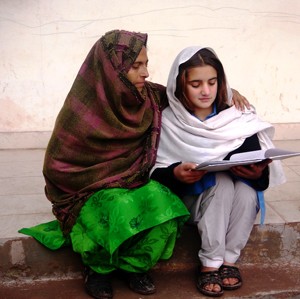
Gul Laila, a resident of Dharian Bambian, Pakistan, can’t read or write, but she still arrives at the local school early every morning. Before heading off to her job as a domestic worker, she stops by the school to ensure all the teachers have shown up for work. Faculty absenteeism has no longer been an issue since the School Management Committee elected Laila as its chairwoman.
Denied an education herself, Laila now works tirelessly to make sure that her daughters and all the other girls of this remote village in Pakistan’s Azad Jammu and Kashmir (AJK) region have access to school.
“When I was growing up, we girls were often discriminated against,” Laila said. “Our parents sent our brothers to school, while asking us to cook for them and clean their uniforms. I don’t want our daughters to have the kind of lives we had. I want them to be educated and make their own decisions.”
An already a bad situation for girls’ education in AJK was exacerbated when the 2005 earthquake struck during school hours, killing nearly 14,000 children and sowing fear into parents’ minds. One silver lining of the tragedy, however, was the unprecedented permission given to USAID to operate in the area. For the first time ever, USAID began a school reconstruction program in the region. The USAID project organized a new management committee to help improve the school near Laila’s home. Laila, a gregarious widow, was the natural choice to head it. The establishment of school management committees is one way USAID works with local communities to improve the quality of instruction and learning. Through training of school teachers in interactive, activity-based methodologies, the program encourages communities to invest in their school system.
“Laila took great interest in her daughters’ education,” said Tahira Khan, head teacher at the school. “Now her interest extends to all the girls in our community. We call them ‘Gul’s Girls’.”
Laila and Khan are a source of inspiration for all the women who have joined the committee. Mothers, teachers, a university student, and even Laila’s aged mother-in-law now form the ranks of those committed to providing an improved education to the girls of their small village.
Together, Laila and Khan have addressed fundamental issues such as enrollment, nearly doubling the number of girls from 40 to almost 80 despite reluctance from some men in the community.
Khan said that in all her years of teaching, she has never seen a committee chairperson as dynamic as Laila. “I am really thankful to her for sharing my burden,” Khan said. “I could not fight on so many fronts alone. Together we have been able to make real progress on behalf of education in our community.”







Comment
Make a general inquiry or suggest an improvement.